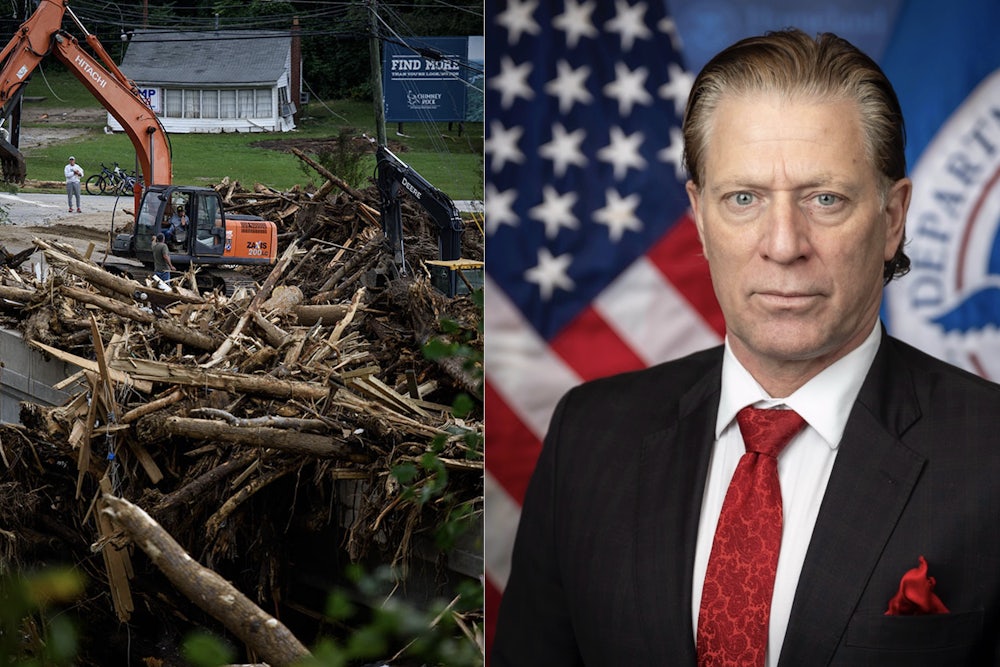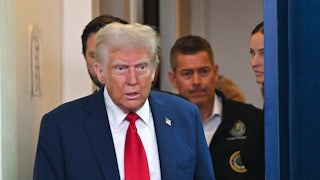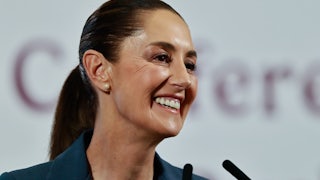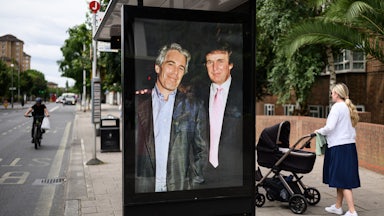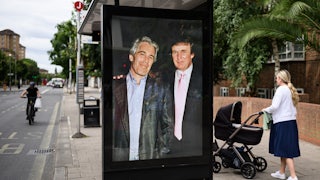“Don’t get in my way,” David Richardson told the staff of the Federal Emergency Management Agency during a 17-minute address at an all-hands meeting last week, on his first day of work. “I will run right over you.” Officially the “senior official performing the duties of FEMA administrator,” Richardson was appointed by the Trump administration after it fired the former acting administrator of FEMA, Cameron Hamilton, who was dismissed shortly after telling members of Congress that he did not believe it was “in the best interest of the American people to eliminate” FEMA, something Trump and Homeland Security Secretary Kristi Noem had talked about doing for months. In his address to his new employees, Richardson invoked his experience as a Marine while railing against the “somewhere south of 20 percent” of people in any organization who “decide they are going to get in the way of change.”
“I—and I alone in FEMA—speak for FEMA,” Richardson added. “I’m here to carry out the president’s intent.”
If all you had to go on was Richardson’s speech, you might be surprised to learn that he harbors the soul of an artist. A lifelong painter, Richardson is also the author of a roughly 400-page novel, published in 2019, called War Story, which he’s described as being “about 80 percent” autobiographical. Given the relatively sparse information available about Richardson, the book—while a work of fiction—offers a window into the mind of the man now responsible for the country’s federal disaster-response infrastructure. If Richardson is anything like his self-aggrandizing lech of a protagonist, War Story doesn’t inspire confidence that he’s either qualified to run FEMA or a pleasant, well-adjusted person.
Having spent most of the last decade as a government contractor in Northern Virginia, Richardson was previously appointed by the Trump administration as assistant secretary for the Department of Homeland Security’s Countering Weapons of Mass Destruction Office. Richardson has no apparent experience with FEMA, emergency management, or disaster relief. He was first commissioned as an officer in the Marine Corps in 1991, serving (according to a C.V. on his LinkedIn page) in Korea, Afghanistan, and Iraq, before leaving the military in 2013. Loosely, War Story is a fictionalized account of his time as an adviser to the Iraqi Army in Anbar Province in 2006. Besides that job, the protagonist, Clarence “Clay” Steerforth, shares several other autobiographical details with Richardson: He is a D.C.-area resident, a cigar smoker, and the son of an artist who taught him to paint from a young age. Steerforth goes to war not because he has to or because he’s especially committed to the cause, but because he’s “dreamed of the adventure of war since childhood.” He stayed in the service through peacetime thanks to the decent pay and the “prospect” of combat. When a war actually begins, Steerforth experiences “great pain being left out,” so volunteers to go. As he tells his artist friend John, “I can’t live with myself … removed from war.”
In War Story, Iraq is a place for Steerforth to realize his calling as a fighter, following—by his own account—in the footsteps of Alexander the Great and the Roman and British Empires: “Now my own war was here, right in the middle of Satan’s front yard where so many had endured or been consumed.” When Steerforth sees a dead body killed on one of his unit’s first patrols, the crimson and white of the deceased’s blood and brains on black asphalt reminds him of Francis Bacon paintings. He doesn’t, of course, mention the estimated 200,000 Iraqi civilians who were killed in the Iraq War, a conflict widely criticized then and now as a reckless, illegal war of aggression.
A few of War Story’s more regrettable chapters are told from the perspective of Abdul Mujeed, a real-life Iraqi colonel whom Richardson worked alongside in Ramadi and Fallujah. The men’s shared love of tea, tobacco, and younger women is what allows Richardson to connect with and build a grudging respect for Mujeed. In one scene, Mujeed—who is married with children—expresses his admiration for “women’s lib” to Steerforth in broken English. Through a translator, we learn that what he actually admires is the fact that in the United States he could divorce his wife, who is no longer “craving sex,” and find a second, younger wife, who is.
About half of War Story, though, follows a 40-year-old Clay in the immediate lead-up to his deployment, as he teaches courses on military history to civilian and ROTC students at the George Washington University. On the home front, he navigates a very different kind of war: attempting to make D.C. gallery owner Barbara Meyerstone pay up the almost $65,000 she owes him for selling his paintings. (While it’s not clear how much Richardson’s works have sold for, he was reportedly asking $90,000 for a painting of Alexandria Ocasio-Cortez stylized as Che Guevara in 2020.)
Steelforth’s paintings are good, which we know because characters in War Story constantly say so. “The touch you have is rare,” his artist friend John tells him. “People respond to your work because they can see you searching.” His mom praises his talents, as does a nameless young Alabaman congressional staffer he sleeps with after attending a 21st birthday celebration for one of his students. “I like your paintings. That cigar smell makes me think of my paw-paw,” she tells him in the morning before kissing him on the cheek.
Like most other women in the book, the congressional staffer finds Steerforth irresistibly charming. The wooed include his “attractive” home-front enemy, Meyerstone the gallerist. Unprompted, Steerforth tells John that he’s seen her naked. “I helped her lay the brick walkway to her front door last summer,” he explains. “When I finished, I called to say I was leaving, and she hollered for me to come out back. I walked around the side of the house, and there she was, sitting in her hot tub, tits and oak leaves floating on the surface as if it was any old Tuesday.” Meyerstone’s young, Eastern European gallery assistant is similarly introduced on her hands and knees, wiping sweat from her face and neck. There aren’t sex scenes in War Story so much as porny setups to sex that may or may not happen.
Steerforth meets his eventual girlfriend—a Mongolian-born college student who goes by Kate—at a Chinese tea room in Georgetown. She’s “thin, with nice hips and a round bottom.” Kate also likes his art, and it draws her to him. “Your paintings are beautiful,” she says after flipping through a draft catalog of his series on the Trojan War. They go on dates where he buys her ice cream, smokes cigars, and says things like, “This waterfront reminds of summer … and painting.” Readers don’t learn much about Kate other than that she lives in an apartment building “full of immigrants” and works in a hat shop. Introducing her to his students, Steerforth jokes that she’s a “real live Mongol.” Kate is inconsolable when he tells her he’s going to Iraq; eventually she’ll leave her mother and sisters behind to join him in North Carolina, where he’s stationed before shipping out.
Down South, Steerforth’s eyes wander when he’s made to work with a woman Marine for the first time. “There was something erotic in her demeanor,” he says of his new co-worker, who has “muscular hands” and “ample hips.” She has just disciplined female recruits for “getting fucked,” which is frowned upon because they keep getting pregnant in order to avoid going to Iraq. “It was as if she’d consumed the pending sexual climax herself, seizing for her own body all the excitement and pleasure by simply bringing the act to an abrupt end: she had affirmed her power.”
The encounter speaks to what might be Richardson’s most persistent gripe in War Story: women in the military. In a chapter told in Mujeed’s voice, his colleague calls the Americans “so soft that they send their daughters to war while their sons stay home and do women’s work.” Women who do make it to war zones are “filthy creatures,” Steerforth groans. His comrades in Iraq complain about the abundance of “feminine napkins” and “colors of mascara” in the store on the base. They nonetheless upload hundreds of nudes those “nasty bitches” took of themselves to a thumb drive after someone left the file open on a recreational computer, ogling their “bad tits,” “pimply asses,” and “ugly faces” in between bouts of heroic combat. Steerforth finds this behavior unseemly, albeit mostly, it seems, because he’s got more refined taste in women.
When an “attractive and charming” female reporter comes to write about America’s training of Iraqi soldiers, Steerforth gruffly shepherds her around and—of course—charms her. On her last night, they stay up late drinking tea and talking. Abby asks how a guy who is “obviously not gay” and seems to have “melted more than one heart with those blue eyes, that crooked grin, and that practiced Southern drawl” could possibly be single. “You play the country bumpkin, but I looked you up on the Internet; besides being a Marine, you’re an artist.” They flirt, and he notices “dampness glistening on her forehead.” Presumably they sleep together.
As a final reward, the story Abby writes brushes over the possible war crime she saw committed on Steerforth’s watch. Mujeed’s unit “kicked the fuck out of” several detainees before his Marines stuff them, bound, bruised, and half-dressed, into the back of an un–air conditioned truck in 100-degree-plus heat. When another officer confronts him about the incident—and the prospect of its becoming an Abu Ghraib–like scandal—Steerforth fantasizes about beating him to a Bacon-esque pulp. “If you’re equating what my Marines and I did to protect a handful of shitheads who threw grenades at our partners to a bunch of college wannabees playing horeshit kiddy games, you’re wrong,” Steerforth sneers. “Plain fucking wrong.” This too is, at least partially, a woman’s fault. The Abu Ghraib scandal, Steerforth concludes, can be chalked up to a “bunch of dumbasses with a camera who joined the Army Reserve for college money and found themselves in a theater of war, led by a female dingbat of a general.” (He is presumably referring to General Janis Kapinski, the commander of the Abu Ghraib prison when members of the U.S. military and the CIA tortured, abused, and killed detainees there in the early stages of the Iraq War.)
War Story briefly touches on the Marines’ 2006 arrest and subsequent two-year imprisonment of Associated Press photographer Bilal Hussein, one of many Iraqi journalists captured and held without charge or evidence by U.S. forces. In the book, Steerforth’s former student at GWU, Brim, is part of a group that captures Hussein on suspicion that he’s sending footage “to Arab news outlets, promoting the good fight against the infidel.” When another officer asks where he might be after getting whisked away—potentially by the State Department—Brim says, “Hopefully dead, but probably in jail.”
In a blurb for War Story, MAGA political operative Corey Lewandowski—now a special government employee and close adviser to Kristi Noem at DHS—called it “funny in places, unapologetic. Will make liberals cringe!” Fair enough: The novel is certainly unapologetic, occasionally—if mostly unintentionally—funny, and likely to make people of various political persuasions cringe. But the stakes of Richardson’s tenure at FEMA may be higher than those faced by any living writer of autofiction. With Atlantic hurricane season now less than three weeks away, FEMA was already grappling with worsening staffing shortages; as many as 20 percent of permanent employees could leave the agency as a result of buyout offers and firings led by the so-called Department of Government Efficiency. Long-standing practices like door-to-door canvassing in disaster areas are being eliminated by fiat, along with congressionally mandated grant making through the Building Resilient Infrastructure and Communities program. Experts and FEMA staffers warn that the agency is dangerously unprepared for this year’s storm season amid ongoing cutbacks that are undermining emergency preparedness at every level of government.
Richardson has stated that he wrote War Story with the intention of exploring why man is fascinated by war. For the most part, however, he just muses about trivialities like how much he enjoys drinking whiskey in a war zone. As he takes the reins at FEMA, the more important question is whether David Richardson is as interested in emergency management as he is in painting, women, and self-mythologizing.
